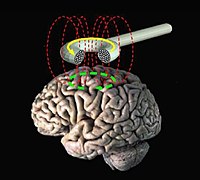
Photo from wikipedia
OBJECTIVE The study tested whether combining repetitive peripheral magnetic stimulation (RPMS) and motor training of the superficial multifidus muscle (MF) better improved the corticomotor control of spine than training alone… Click to show full abstract
OBJECTIVE The study tested whether combining repetitive peripheral magnetic stimulation (RPMS) and motor training of the superficial multifidus muscle (MF) better improved the corticomotor control of spine than training alone in chronic low back pain (CLBP). METHODS Twenty-one participants with CLBP were randomly allocated to [RPMS+training] and [Sham+training] groups for three sessions (S1-S3) over a week where MF was stimulated before training (volitional contraction). Training was also home-practiced twice a day. Changes were tested at S1 and S3 for anticipatory postural adjustments (APAs) of MF and semi-tendinosus (ST), MF EMG activation, cortical motor plasticity (transcranial magnetic stimulation) and pain/disability. RESULTS The RPMS group showed immediate decrease of pain at S1, then improvement of MF activation, ST APA, M1 facilitation, and pain/disability at S3. Changes were larger when brain excitability was lower at baseline. Disability index remained improved one month later. CONCLUSIONS Combining RPMS with training of MF in CLBP impacted motor planning, MF and lumbopelvic spine motor control and pain/disability one week after the onset of protocol. Brain plasticity might have favoured motor learning and improved daily lumbopelvic spine control without pain generation. SIGNIFICANCE Clinically, RPMS impacted the function by improving the gains beyond those reached by training alone in CLBP.
Journal Title: Clinical Neurophysiology
Year Published: 2017
Link to full text (if available)
Share on Social Media: Sign Up to like & get
recommendations!